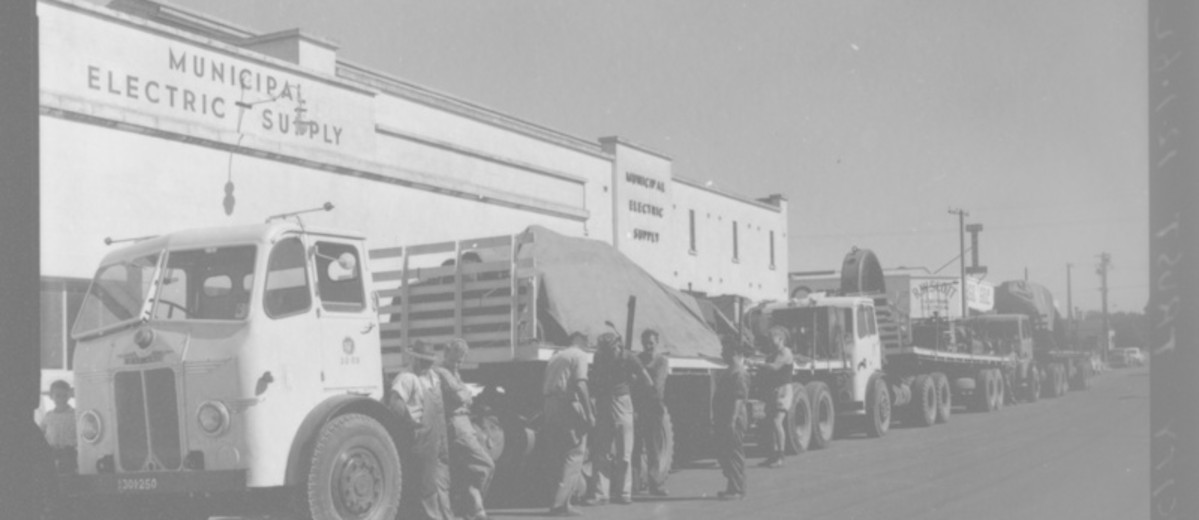Subject
ContributeAlthough amateur scientists had tinkered with it, electricity was not put to public use in South Australia until the arrival in 1855 of Charles Todd, who pioneered electrical telegraphic communications and introduced the notion of using electricity for street lighting.
The establishment of the first public electricity supply in England in 1882 assisted the passage of a private member’s bill in the colonial parliament for the creation of the South Australian Electric Company in that same year. This company came to nothing, and for over a decade plans to introduce electricity were thwarted by opponents, mainly shareholders in the South Australian Gas Company.
South Australian Electric Light and Motive Power Company
Finally, in March 1895 the South Australian Electric Light and Motive Power Company was registered, supplying power from its Nile Street generator to Port Adelaide on 1 January 1899. In 1900 Adelaide was supplied with electricity from a temporary facility in Tam O’Shanter Place and in November 1901 a new coal-fired powerhouse in Grenfell Street was opened, supplying North Adelaide by 1902. On 31 August 1904 the company was purchased by the Adelaide Electric Supply Company Ltd (AESCo), which spread transmission into the suburbs, quickly gaining consumers, including the electric tramways.
Faced with a demand for power well beyond the generation capacity of the Grenfell Street plant, by 1926 AESCo had constructed substations throughout Adelaide, extending transmission over the suburbs and into rural areas. The success of this extension was largely due to the creation of a cheap, functional stobie pole by one of AESCo’s engineers.
Creation of the Electricity Trust of South Australia (ETSA)
Through the 1930s and early 1940s AESCo promoted the use of electricity. Yet the public’s dependence on this monopoly worried the government. When Tom Playford became premier in 1938 he set about reforming the electricity industry, championing the use of low grade Leigh Creek coal in AESCo’s generation plants. Assisted by war-time regulations and popular support, Playford forced a royal commission into AESCo, then nationalised it to create, in September 1946, the Electricity Trust of South Australia (ETSA).
For the next 25 years electricity spread throughout South Australia, expanding industry and agricultural production. Even before ETSA arrived at many rural localities, private companies and local government had installed their own generators. Electricity was a symbol of advancement, prestige and modernity for communities and the state. New power stations were built at Port Augusta and Torrens Island, and ETSA expanded with few external controls.
As environmental issues became prominent, ETSA’s engineers explored solar, wind and water-generated power, and also continued its search for fossil fuels, particularly coal and natural gas. Assisted by the production of more affordable and compact storage cells and other technology, private individuals have explored and implemented numerous small schemes utilising particularly solar and wind power.
In the late 1980s, following interconnection of electricity supplies between New South Wales, Victoria and South Australia and increased government interest in cutting costs and reducing public ownership, ETSA was reorganised, the reconstruction continuing into the 1990s. Despite the success of this revamp ETSA was targeted for privatisation and by 2000 all sections of the Trust had reverted to private ownership.
Media
Add mediaImages

Image courtesy of the State Library of South Australia, Arthur Family Photographic Collection, SLSA: BRG 347/1855, Public Domain.

Image courtesy of the State Library of South Australia, Arthur Family Photographic Collection, SLSA: BRG 347/1279, Public Domain.





CommentAdd new comment
Quickly, it's still quiet here; be the first to have your say!